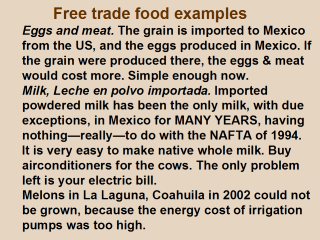| front |1 |2 |3 |4 |5 |6 |7 |8 |9 |10 |11 |12 |13 |14 |15 |16 |17 |18 |19 |20 |review |
 |
Cattle grown
in northern Mexico can follow: 1/ raise calves then 2/ export them to the US
for further growth. That works, despite high TB and brucellosis rates.
The importation of milk goats to Mexico in the 60s-70s ended in a rather large bar-b-q in 1994 when subsidies were withdrawn. Lack of rainfall and the corynebacterial disease caseous lymphadenitis are the causes of complete failure. Mexico has meat goats as cabrito al pastor, not ! milk goats. The fantastic import idea was that goats could compete with Wisconsin dairy cattle. Milk goats are ANTIECONOMIC. Wintertime tomatoes remain a profitable crop. Tropical crops including coffee remain highly viable, although the competition among countries growing sugar is high. For years these lands of fast runoff silted rivers have been cleaned of nitrogen and phosphate without fertilizer replacement. What is left to "exploit?" The remaining forests. Nomads scrape out shortlived farms on the one hand, and on the other are we face the multinational loggers. The value in clearing the land is some nitrogen for a year or 2, then infertility again. Corn, sorghum or another 3-month crop need most water when they bloom and seed, booting out. Many a crop will die "on the vine." |